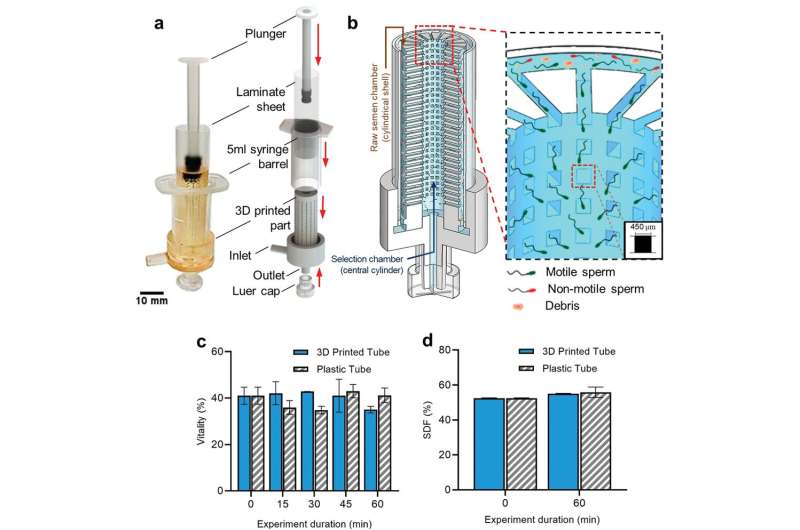
A Monash University-developed syringe that uses a 3D filter to detect viable sperm can increase sperm quality selection by 65%, bringing new hope to infertile couples.
The world-first syringe can isolate quality sperm in less than 15 minutes, and is the biggest innovation in sperm selection technology in 30 years.
The breakthrough, made by a team of Monash bioengineering researchers, harnesses simple plastic syringe technology, which can be readily mass produced, bringing hope and cheaper treatment solutions to 180 million people affected by infertility worldwide.
The syringe works by drawing 1.5 milliliters of semen into a chamber that then passes through a network of 560 parallel microchannels (tiny cylinders). The quality sperm swim through the microchannels into the selection chamber, where they can be extracted, leaving the poor-quality sperm behind. This process takes less than 15 minutes and is able to retrieve more than 41% of healthy sperm from the sample.
Using this method, researchers can improve the quality of sperm selection by more than 65%. This dramatically reduces the need for complex and invasive intracytoplasmic sperm injection procedures (injecting a single sperm into an egg), in favor of artificial insemination directly into the uterus.
Supervising researcher Dr. Resa Nosrati of Monash’s Department of Mechanical and Aerospace Engineering said the innovation would ultimately result in higher success rates for couples seeking fertility treatment, at lower cost.
“Sperm selection is a crucial part of infertility treatment, but the conventional clinical methods for sperm selection haven’t changed over the past 30 years,” Dr. Nosrati said. Due to this lack of technological developments, the success rate of treatment methods has stagnated at 35% per cycle.
“Using the sperm syringe we can select sperm with over 65% improvement in DNA integrity and morphology (make-up), and since DNA quality is directly linked with fertilization success, we expect to improve assisted reproductive technology (ART) outcomes. This technology can help to standardize and streamline the sperm selection process in fertility clinics.”
The research—published in Advanced Materials Technologies—was led by Ph.D. candidate Farin Yazdan Parast under the supervision of Dr. Reza Nosrati and Professor Moira O’Bryan.
Ms Yazdan Parast said, “The sperm syringe provides a high-throughput device for one-step semen purification and sperm selection. The 3D sorting platform provides the maximum contact area between the semen sample and selection events by arranging microchannels in a 3D structure to enable highly parallelised and rapid sorting.
“Due to this considerably high surface-to-volume ratio, active sperm can easily find and enter the microchannels, leaving the raw sample behind. This provides an effective selection mechanism that outperforms both conventional clinical methods and other more recent sperm selection technologies.”
The sperm syringe has been patented and the researchers are examining how to commercialize the device for use in fertility clinics. Further clinical testing is also planned.
Monash University

